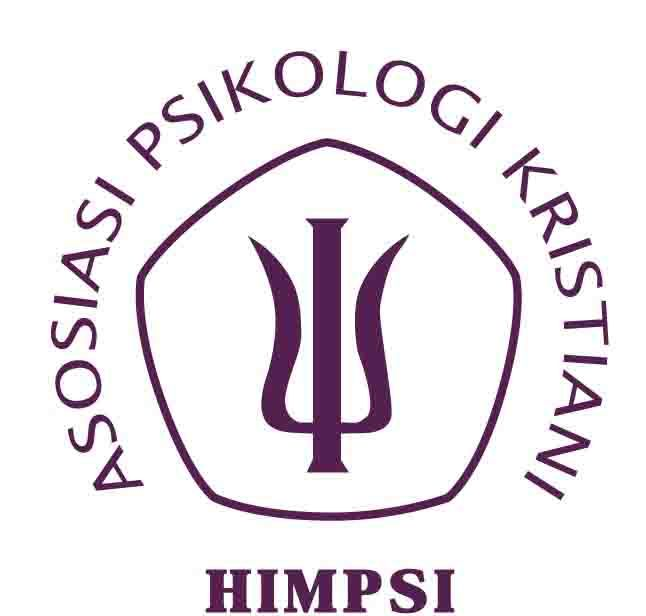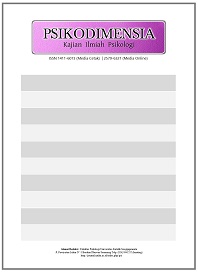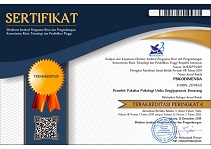Trauma Masa Anak dan Kecenderungan Kreativitas Jahat: Mengungkap Peran Resiliensi pada Mahasiswa
Abstract
Individu yang memiliki kecenderungan kreativitas jahat dapat membahayakan diri sendiri, orang lain, dan lingkungan sekitarnya. Individu yang cenderung memiliki kreativitas jahat dipengaruhi adanya trauma masa anak yang tidak terselesaikan. Resiliensi dianggap sebagai faktor protektif trauma masa anak dan kreativitas jahat, namun penelitian yang berfokus resiliensi dalam hubungan antara trauma masa anak dan kreativitas jahat pada mahasiswa belum banyak mendapat perhatian di Indonesia. Tujuan dari penelitian ini mengungkap peran resiliensi terhadap hubungan antara trauma masa anak dan kreativitas jahat. Hipotesis penelitian ini adalah resiliensi memoderasi hubungan antara trauma masa anak dan kecenderungan kreativitas jahat pada mahasiswa. Subjek penelitian terdiri dari 157 mahasiswa usia 18-26 tahun yang menyelesaikan Childhood Trauma Questionnaire-Short Form (CTQ-SF), Malevolent Creativity Behavioral Scale (MCBS), dan Connor-Davidson Resilience Scale (CD-RISC). Pengujian hipotesis dilakukan dengan moderasi PROCESS Hayes Model 1. Hasil analisis menunjukkan bahwa terdapat hubungan positif antara trauma masa anak dan kreativitas jahat dengan resiliensi (β=0,264;p<0,05); trauma masa anak dengan kreativitas jahat berhubungan positif (β=0,253;p<0,01); trauma masa anak dengan resiliensi berhubungan negatif (β=-0,135;p<0,01), sedangkan resiliensi dengan kreativitas jahat tidak memiliki hubungan (β=-0,135;p<0,05). Hipotesis penelitian ini tidak terbukti bahwa resiliensi tidak memoderasi hubungan antara trauma masa anak dengan kecenderungan kreativitas jahat pada mahasiswa.
Keywords
Full Text:
PDF (Bahasa Indonesia)References
Baas, M., Roskes, M., Koch, S., Cheng, Y., & De Dreu, C.K.W. (2019). Why social threat motivates malevolent creativity. Personality and Social Psychology Bulletin, 45(11), 1590-1602. https://doi.org/10.1177/0146167219838551.
Badan Pusat Statistik, 2023, Statistik Kriminal 2023, Volume 14, No.04300.2306, Badan Pusat Statistik.
Beaussart, M.L., Andrews, C.J., & Kaufman, J.C. (2013). Creative liars: The relationship between creativity and integrity. Thinking Skills and Creativity, 9, 129-134. https://doi.org/10.1016/j.tsc.2012.10.003.
Bedu-Addo, P.K.A., Mahama, I.M., Amoako, B.M., Amos, P.M., & Antwi, T. (2023). Neglectful parenting and personality traits as predictors of malevolent creativity among Ghanaian tertiary education students. Creative Education, 14(2). https://doi.org/10.4236/ce.2023.142016.
Bernstein, D.P., Stein, J.A., Newcomb, M.D., Walker, E., Pogge, D., Ahluvalia, T., Stokes, J., Handelsman, L., Medrano, M., Desmond, D., & Zule, W. (2003). Development and validation of a brief screening version of the Childhood Trauma Questionnaire. Child Abuse and Neglect, 27, 169-190. 10.1016/S0145-2134(02)00541-0.
Bonanno, G.A., & Mancini, A.D. (2012). Beyond resilience and PTSD: Mapping the heterogeneity of responses to potential trauma. Psychological Trauma: Theory, Research, Practice, and Policy, 4(1), 74-83. https://psycnet.apa.org/doi/10.1037/a0017829.
Bulathwatta, A., & Lakshika, R. (2023). Role of emotional creativity and achievement motivation on trauma symptoms among university students. Frontiers in Psychology, 14. https://doi.org/10.3389/fpsyg.2023.1203226.
Ceballos, N.A., & Watt, T.T. (2023). The influence of adverse childhood experience on malevolent creativity in young adulthood. Behavioral Science, 13(12), 961. https://doi.org/10.3390/bs13120961.
Chang, Y.H., Yang, C.T., & Hsieh, S. (2023). Social support enhances the mediating effect of psychological resilience on the relationship between life satisfaction and depressive symptom severity. Scientific Reports, 13(4818). https://doi.org/10.1038/s41598-023-31863-7.
Clement, L.M., & Bradley-Garcia, M. (2022). A step-by-step tutorial for performing a moderated mediation analysis using PROCESS. The Quantitative Methods for Psychology, 18(3), 258-271. https://doi.org/10.20982/tqmp.18.3.p258.
Cropley, D.H., Kaufman, J.C., & Cropley, A.J. (2008). Malevolent creativity: a functional model of creativity in terrorism and crime. Creativity Research Journal, 20(2), 105-115. 10.1080/10400410802059424.
Cropley, A.J. (2016). The dark side of engineering creativity. International of Creativity and Problem Solving, 26(2), 7-21. https://www.researchgate.net/publication/332318722_The_dark_side_of_engineering_creativity.
Cropley, D.H., Kaufman, J.C., White, A.E., & Chiera, B.A. (2014). Layperson perceptions of malevolent creativity: The good, the bad, and the ambiguous. Psychology of Aesthetics, Creativity and the Arts, 8(4), 400-412. https://psycnet.apa.org/doi/10.1037/a0037792.
Cui, X., Zhang, X., & Zhang, H. (2024). The impact of parenting style on malevolent creativity based on Chinese university students: a latent profile analysis. Frontiers in Psychology, 15. 10.3389/fpsyg.2024.1363778.
Diah, D.N., Lubis, F.Y., & Witriani, W. (2020). Efek moderasi resiliensi terhadap hubungan antara perfeksionisme dengan kecemasan mengerjakan skripsi. Gadjah Mada Journal of Psychology, 6(2), 178-190. https://doi.org/10.22146/gamajop.55349.
Friedberg, A., & Malefakis, D. (2018). Resilience, trauma, and coping. Psychodynamic Psychiatry, 46(1), 81-113. https://guilfordjournals.com/doi/epdf/10.1521/pdps.2022.50.2.382.
Fu, H., & Zhang, Z. (2022). The inhibitory effect of moral emotions on malevolent creativity: exploring the mediation role of emotional valence and prosocial behavior. Frontiers in Psychology, 13, (945848), 1-11. https://doi.org/10.3389/fpsyg.2022.945848.
Galindo-Dominguez, H., Pegalajar, M., & Uriarte, J.D.D. (2020). Mediator and moderator effect of resilience between self-efficacy and burnout amongst social and legal sciences faculty members. Revista de Psicodidactica (English Edition), 25, 127-135. https://doi.org/10.1016/j.psicod.2020.04.002.
Gazos, A., Madeira, O., Plattner, G., Roller, T., & Buscher, C. (2024). New and emerging perspectives for technology assessment: Malevolent creativity and civil security, Journal for Technology Assessment in Theory and Practice, 3(2), https://doi.org/10.14512/tatup.33.2.09.
Gupta, S., 11 Desember 2024, What Is Trauma Therapy, verywellmind, tanggal akses 17 Februari 2025, https://www.verywellmind.com/trauma-therapy-definition-types-techniques-and-efficacy-5191413.
Gutworth, M.B., Cushenbery, L., & Hunter, S.T. (2018). Creativity for deliberate harm: Malevolent creativity and social information processing theory. The Journal of Creative Behavior, 52, 305-22. https://doi.org/10.1002/jocb.155.
Hao, N., Qiao, X., Cheng, R., Lu, K., Tang, M.Y., & Runco, M.A. (2020). Approach motivational orientation enhances malevolent creativity. Acta Psychologica, 203(102985). https://doi.org/10.1016/j.actpsy.2019.102985.
Hao, N., Tang, M., Yang, J., Wang, Q.F., & Runco, M.A. (2016). A new tool to measure malevolent creativity: The malevolent creativity behavior scale. Frontiers in Psychology, Vol.7, No.682. https://doi.org/10.3389/fpsyg.2016.00682.
Harris, D.J., Reiter-Palmon, R., & Kaufman, J.C. (2013). The effect of emotional intelligence and task type on malevolent creativity, Psychology of Aesthetics, Creativity, and the Arts, Vol.7, No.3, h.237-244, http://dx.doi.org/10.1037/a0032139.
Harris, D. J., & Reiter-Palmon, R. (2015). Fast and furious: The influence of implicit aggression, premeditation, and provoking situations on malevolent creativity. Psychology of Aesthetics, Creativity, and the Arts, 9(1), 54–64. https://doi.org/10.1037/a0038499.
Hayes, A.F., 2022, Introduction to Mediation, Moderation, and Conditional Process Analysis: A Regression-Based Approach Third Edition. New York: The Guildford Press.
Hendriani, W., (2022), Resiliensi Psikologis Sebuah Pengantar Edisi Pertama. Jakarta: Kencana.
Hill-Berry, N.P., & Burris-Melville, T.S. (2024). When the going gets tough: educational leadership and resilience in times of crises. Power and Education, 0(0), 1-25. https://doi.org/10.1177/17577438241297242.
Hu, H., Chen, C., Xu, B., & Wang, D. (2024). Moderating and mediating effects of resilience between childhood trauma and psychotic-like experience among college students. BMC Psychiatry, Vol. 24, No.273. https://doi.org/10.1186/s12888-024-05719-x
Ito, S., Morishita, C., Masuya, C., Ono, M., Honyashiki, M., Higashi, S., Tamada, Y., Fujimura, Y., & Inoue, T. (2022). Moderating and mediating effects of resilience together with neuroticism on depressive symptoms in adult volunteers. Neuropsychiatric Disease and Treatment, 2022(18). https://doi.org/10.2147/NDT.S370201.
Jia, X., Wang, Q., & Lin, L. (2020). The relationship between childhood neglect and malevolent creativity: The mediating effect of the dark triad personality. Frontiers in Psychology, 11. https://doi.org/10.3389/fpsyg.2020.613695.
Jing, Q., Rashid, R.B.A., Peng, C.F., & Yin, C.W. (2023). Trauma exposure and malevolent creativity in higher education: A mediated-moderation analysis of psychological distress and social factors. Eurasian Journal of Educational Research, 105, 179-198. 10.14689/ejer.2023.105.011.
Jonason, P.K., Abboud, R., Tome, J., Dummett, M., Hazer, A. (2017). The dark triad traits and individual differences in self-reported and other-ratedcreativity. Personality and Individual Differences, 117(15), 150-154. https://doi.org/10.1016/j.paid.2017.06.00
Katie, A.D., Vera, B., Xiaochen, L., Tracy, A.P., & Leon, H. (2022). Therapists’ resilience and posttraumatic growth during the COVID-19 pandemic. Psychological Trauma: Theory, Research, Practice, and Policy, 14(1), 165-173. https://psycnet.apa.org/doi/10.1037/tra0001097.
Kapoor, H., & Kaufman, J.C. (2022). The evil within: The AMORAL model of dark creativity. Theoretical Psychology, Vol.32, h.467-490. https://doi.org/10.1177/09593543221074326.
Kusristanti, C., Triman, A., & Paramitha, R.G. (2020). Resiliensi trauma pada dewasa muda penyintas kekerasan yang terindikasi posttraumatic stress disorder (PTSD). Personifikasi Jurnal Ilmu Psikologi, 11(1), 16-33. http://dx.doi.org/10.21107/personifikasi.v11i1.7287.
Lanz, J.J., & Bruk-Lee, V. (2017). Resilience as a moderator of the indirect effects of conflict and workload on job outcomes among nurses. Journal of Advanced Nursing, 73(12), 2973-2986. https://doi.org/10.1111/jan.13383.
Li, W., Zhang, L., Qin, Z., Chen, J., & Liu, C. (2022). Childhood trauma and malevolent creativity in Chinese college students: moderated mediation by psychological resilience and aggression. Journal of Intelligence, 10(4), 1-6. https://doi.org/10.3390/jintelligence10040097.
Li, G., & Zhu, J. (2024). Childhood trauma and malevolent creativity in Chinese college students: The chain mediation role of positive parenting and resilience. Journal of Education and e-Learning Research, 11(3), 622-631. 10.20448/jeelr.v11i3.5972.
Listiyandini, R.A., & Akmal, S.Z., 1 Agustus 2015, Hubungan antara kekuatan karakter dan resiliensi pada mahasiswa, Conference: Prosiding Temu Ilmiah Nasional Psikologi, ResearchGate, diunduh pada tanggal 23 Agustus 2024. https://www.researchgate.net/publication/318125685_Hubungan_Antara_Kekuatan_Karakter_dan_Resiliensi_pada_Mahasiswa.
Ma, Y., Chen, S., Dong, H., Guo, R., Liu, R., Xie, J., & Sun, Z. (2024). Relationship between resilience, social support, existential well-being and negative emotions in cervical cancer patients: A mediation analysis. Journal of Cancer, 15(11), 3418-3426. https://doi.org/10.7150/jca.91260.
McLaughlin, K.A., & Lambert, H.K. (2017). Childhood trauma exposure and psychopathology: mechanism of risk and resilience. Current Opinion in Psychology, 14, 29-34. https://doi.org/10.1016/j.copsyc.2016.10.004.
Min, J.A., Lee, C.U., & Chae, J.H. (2015). Resilience moderates the risk of depression and anxiety symptoms on suicidal ideation in patients with depression and/or anxiety disorders. Comprehensive Psychiatry, 56, 103-111. https://doi.org/10.1016/j.comppsych.2014.07.022.
Nie, H. (2024). The effect of forgiveness on Malevolent Creativity among College Students: Chain mediating effects of anger and revenge motivation. Authorea. https://doi.org/10.22541/au.172163239.93089611/v1.
Oviedo, L., Seryczynska, B., Torralba, J., Roszak, P., Angel, J.D., Vyshynska, O., Muzychuk, I., & Churpita,S. (2022). Coping and resilience strategies among Ukraine war refugees. International Journal of Environmental Research and Public Health, 19(20), https://doi.org/10.3390/ijerph19201309.
Perchtold-Stefan, C.M., Fink, A., Rominger, C., & Papousek, I. (2020). Creative, antagonistic, and angry? Exploring the roots of malevolent creativity with a real – world idea generation task. The Journal of Creative Behavior, Vol.55, No.3, h.710-722. https://doi.org/10.1002/jocb.484.
Perchtold-Stefan, C.M., Fink, A., Rominger, C., & Popousek, I. (2022). Social exclusion increases antisocial tendencies: Evidence from retaliatory ideation in a malevolent creativity task, Psychology of Aesthetics, Creativity, and the Arts, https://psycnet.apa.org/doi/10.1037/aca0000500.
Perchtold-Stefan, C.M., Rominger, C., Fink, A. (2023). Depressive symptoms are positively linked to malevolent creativity: A novel perspective on the maladaptive nature of revenge ideation. The Journal of Creative Behavior, 57(2), 319-330. https://doi.org/10.1002/jocb.580.
Pusiknas Bareskrim Polri, 21 Juni 2023, Kekerasan dan kejahatan bersenjata lebih banyak melibatkan pelajar serta mahasiswa, diunduh 30 Maret 2024, https://pusiknas.polri.go.id/detail_artikel/kekerasan_dan_kejahatan_%E2%80%98bersenjata%E2%80%99_lebih_banyak_melibatkan_pelajar_serta_mahasiswa.
Runco, M.A., 2007, Creativity: Theories and themes: Research, Development, and Practice, London, Elsevier Academic Press.
Rui, C., Kelong, L., & Ning, H. (2021). The effect of anger on malevolent creativity and strategies for its emotion regulation. Acta Psychologica Sinica, 53(7), 847-860. https://doi.org/10.3724.
Salsabila, R., Karmiyati, D., & Hijrianti, U.R. (2019). Hubungan antara forgiveness dengan resiliensi pada penyintas pasca konflik di Aceh. Cognicia, 7(1). https://doi.org/10.22219/cognicia.v7i1.8156.
Sinambela, M.L. (2024). Psikologi trauma menyembuhkan diri dari pengalaman traumatis, Psikologi, 1(4), 1-15. https://circle-archive.com/index.php/carc/article/view/163.
Siotia, S., Harris-Britt, A., Cornelius, A., & Walk, K. (2023). Navigating the nexus: Childhood trauma, sexually coercive behaviour, dark tetrad personality traits, and sexual fantasy. Journal of Sexual Medicine & Research, 2(3), 1-8. doi.org/10.47363/JSMR/2023(2)117.
Sisto, A., Vicinanza, F., Campanozzi, L.L., Ricci, G., Tartaglini, D., & Tambone V. (2019). Towards a Transversal Definition of Psychological Resilience: A Literature Review. Medicina (Kaunas), 55(11). doi: 10.3390/medicina55110745.
Southwick, S.M., Bonanno, G.A., Masten, A.S., Panter-Brick, C., & Yehuda, R. (2014). Resilience definition, theory, and challenges: interdisciplinary perspective. European Journal of Psychotraumatology, 5(1). https://doi.org/10.3402/ejpt.v5.25338.
Sujarweni, V.W., & Utami, L.R., 2023, The guide book of SPSS: Cara mudah dan cepat mengolah data penelitian dengan SPSS. Yogyakarta: Penerbit Anak Hebat Indonesia.
Szabo, E., Kormendi, A., Kurucz, G., Cropley, D., Olajos, T., & Pataky, N. (2022). Personality traits as predictors of malevolent creative ideation in offenders. Behavioral Sciences, 12(7), 242. https://doi.org/10.3390/bs12070242.
Trisakusumo, D., 26 Januari 2024, Aktivis mahasiswa: Agen perubahan untuk demokrasi di Indonesia, News, Artikel Online, diakses pada tanggal 29 Agustus 2024, https://fib.unair.ac.id/fib/2024/01/26/aktivis-mahasiswa-agen-perubahan-untuk-demokrasi-di-indonesia/.
Turyadi, I., Mulyati, Y., & Sakinah, R.M.N. (2024). Metode resiliensi pada pelayanan trauma healing: Penanggulangan korban bencana pada anak di Desa Mangunkerta Kecamatan Cugenang Kabupaten Cianjur. Sawala: Jurnal Pengabdian Masyarakat Pembangunan Sosial, Desa, dan Masyarakat, 5(2), 221-234. e ISSN: 2716-4705.
Wais, M., Ensink, K., Begin, M., & Sharp, C. (2024). Trauma-related symptoms in adolescents: the differential roles of sexual abuse and mentalizing. Frontiers in Psychology, 15. https://doi.org/10.3389/fpsyg.2024.1364001.
Wang, D., Wang, D., & Chen, W. (2022). The relationship between adolescents’ resilience and their malevolent creativity behaviors. Acta Psychologia Sinica, 54(2), 154-167. https://psycnet.apa.org/doi/10.3724/SP.J.1041.2022.00154.
Wang, Y., Zhang, K., Xu, F., Zong, Y., Chen, L., & Li, W. (2024). The effect of justice sensitivity on malevolent creativity: The mediating role of anger and the moderating role of emotion regulation strategies. BMC Psychology, 12(265), 1-11, https://doi.org/10.1186/s40359-024-01759-w.
Watters, E.R., Aloe, A.M., & Wojciak, A.S. (2023). Examining the association between childhood trauma, resilience, and depression: A multivariate meta-analysis. Trauma, Violence, & Abuse, 24(1), 231-244. https://doi.org/10.1177/15248380211029397.
Widyorini, E., Roswita, M.Y., Primastuti, E., & Wijaya, D.A. (2022). The role of resilience towards the correlation between adverse childhood experiences and post-traumatic growth. The Open Psychology Journal, 15. http://dx.doi.org/10.2174/18743501-v15-e2203280.
Yoon, S., Howell, K., Dillard, R., McCarthy, K.S., Napier, T.R., & Pei, F. (2019). Resilience following child maltreatment: Definitional consideration and developmental variations. Trauma Violence, & Abuse, 1-19. https://doi.org/10.1177/1524838019869094.
Zhang, W., Liang, Q., Qiao, X., & Hao, N. (2024). Unfairness brings malice: Malevolent creativity is modulated by perceived unfairness of others, Thinking Skills and Creativity, Vol.53, 101586, https://doi.org/10.1016/j.tsc.2024.101586.
Zhao, J., Xu, X., & Pang, W. (2022). When do creative people engage in malevolent creativity behaviors? The moderating role of moral reasoning. Personality and Individual Differences, 186(Part B), 111386. https://psycnet.apa.org/doi/10.1016/j.paid.2021.111386.
Zong, X., & Dong, H. (2023). A study on the relationship between social exclusion and malevolent creativity of hard-of-hearing students, Academic Journal of Humanities & Social Sciences, Vol.6, No.25, h.106-111, 10.25236/AJHSS.2023.062517.
DOI: https://doi.org/10.24167/psidim.v23i2.13510
Print ISSN : 1411-6073 | online ISSN : 2579-6321 View My Stats

This work is licensed under a Creative Commons Attribution 4.0 International License.




















